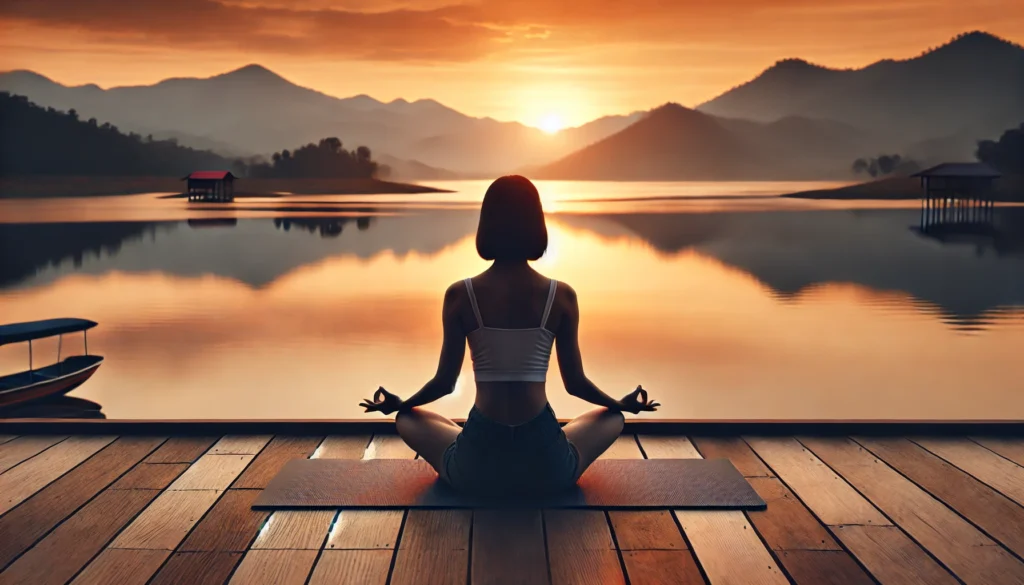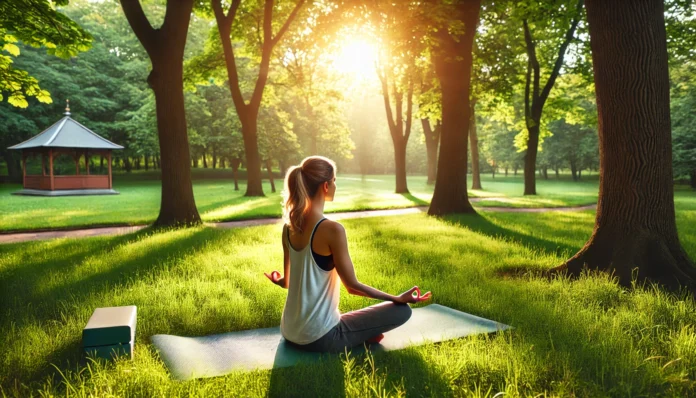Yoga and Breath-Centered Movement as Tools for Inner Calm
Yoga stands at the intersection of physical movement, breath regulation, and mindfulness, making it a particularly powerful modality for managing anxiety. Unlike high-intensity exercises that primarily focus on cardiovascular output, yoga emphasizes balance, control, and presence. These qualities are particularly important for individuals whose anxiety manifests in physical symptoms such as muscle tension, shallow breathing, or a racing heart. Research has demonstrated that yoga not only improves physical flexibility and strength but also reduces symptoms of generalized anxiety disorder and enhances parasympathetic nervous system function—the branch responsible for rest and digestion.
You may also like: Proven Relaxation Techniques for Stress and Anxiety: Evidence-Based Strategies to Calm Your Mind and Body
The therapeutic value of yoga lies largely in its ability to anchor awareness in the present moment. Each posture, or asana, demands a certain degree of attentiveness, challenging the practitioner to remain focused on their breath and bodily sensations. This inward focus interrupts the cycle of anxious rumination and redirects mental energy toward embodiment and grounding. Poses like Child’s Pose (Balasana), Legs-Up-the-Wall (Viparita Karani), and Seated Forward Fold (Paschimottanasana) are particularly calming, as they promote a sense of inward turning and surrender, which is antithetical to the hypervigilance often experienced in anxiety.
Moreover, yoga integrates pranayama—structured breathing exercises that regulate the nervous system and induce a state of calm. Slow, controlled breathing has been shown to activate the vagus nerve, which in turn lowers heart rate and blood pressure while increasing feelings of safety and connection. Practices such as alternate nostril breathing (Nadi Shodhana) or the 4-7-8 technique serve as effective mental exercises for anxiety, helping practitioners develop greater awareness of their physiological state and intervene before stress escalates into a full-blown anxiety episode.
Yoga also encourages a compassionate relationship with oneself, which can be deeply healing for adults who experience anxiety driven by perfectionism, self-criticism, or fear of failure. By fostering a non-judgmental space for exploration, yoga supports emotional regulation and encourages resilience. This makes it not only an anxiety activity but also a long-term practice of emotional cultivation. Over time, individuals often report improved sleep, reduced muscle tension, and enhanced coping skills—all critical outcomes for those managing chronic stress and anxiety.
As adults explore exercises to relieve stress and anxiety, yoga offers a multifaceted approach that meets both the physiological and psychological needs of the individual. It requires no special equipment, can be adapted to any skill level, and can be practiced virtually anywhere, making it a versatile and sustainable choice. By committing to even short daily sessions, individuals can begin to rewire their stress responses and invite a deeper sense of peace and self-connection into their daily lives. Aerobic Exercise and Its Role in Reducing Anxiety Symptoms
Among the various forms of movement, aerobic exercise remains one of the most well-documented methods for alleviating anxiety. Activities such as brisk walking, running, cycling, or swimming not only enhance cardiovascular health but also exert powerful psychological benefits. Engaging in aerobic workouts leads to the consistent release of endorphins and other mood-stabilizing chemicals, which helps counteract the biochemical imbalances often associated with chronic anxiety. In fact, multiple meta-analyses have shown that aerobic activity is as effective as some forms of medication in reducing symptoms of mild to moderate anxiety, without the side effects often associated with pharmacological interventions.
Aerobic exercise enhances oxygen flow to the brain, supporting cognitive function and emotional regulation. As adults face increasing cognitive demands—whether in their careers, caregiving responsibilities, or social roles—this improved mental clarity becomes a vital tool in stress resilience. Moreover, engaging in rhythmic, repetitive aerobic movements creates a state of flow, a concept popularized by psychologist Mihaly Csikszentmihalyi. In this state, the mind becomes fully absorbed in the task at hand, creating a temporary suspension of anxious rumination and self-critical thoughts. This immersion fosters a sense of presence and calm, allowing the body to discharge accumulated stress more effectively.
One particularly compelling reason aerobic movement qualifies as a top-tier anxiety activity is its adaptability. Adults can tailor intensity levels to match their physical capabilities and preferences, making it an inclusive form of therapy. A brisk walk in the morning sun, for example, combines the benefits of physical exertion, exposure to natural light, and circadian rhythm regulation—each of which plays a critical role in anxiety reduction. For those with limited mobility or underlying health concerns, low-impact options like cycling or water aerobics offer comparable psychological benefits without overexertion.
The long-term effects of regular aerobic exercise on anxiety symptoms extend beyond the immediate neurochemical response. Over time, consistent physical activity contributes to increased heart rate variability (HRV), a physiological marker of how well the body can adapt to stress. Higher HRV is associated with greater emotional regulation and lower vulnerability to anxiety disorders. This means that as adults incorporate aerobic routines into their weekly schedules, they are not just managing anxiety—they are actively rewiring their stress response systems to become more resilient.
For individuals seeking accessible, effective anxiety exercises for adults, aerobic movement offers a holistic solution. It bridges the gap between physical health and mental stability, requiring no expensive equipment or specialized training. By prioritizing consistency and self-awareness, adults can transform this form of movement into a cornerstone of their mental wellness practice, reaping both immediate relief and sustained psychological strength. Science Behind Movement as Medicine for Anxiety

Modern neuroscience continues to uncover the profound relationship between physical activity and emotional well-being. Exercise doesn’t merely distract the mind from anxious thoughts—it catalyzes biological processes that directly improve brain function and mood stability. One of the most notable benefits is the release of endorphins, the body’s natural mood elevators. These neurochemicals bind to opioid receptors in the brain, leading to a decrease in the perception of pain and a noticeable lift in mood. More than a temporary boost, consistent exercise helps regulate neurotransmitters such as serotonin and dopamine, both of which play crucial roles in emotional regulation and resilience to stress.
Equally important is exercise’s ability to lower the body’s stress hormones, including cortisol and adrenaline. In today’s fast-paced environment, these hormones are often elevated for extended periods, contributing to chronic tension, insomnia, and irritability. Studies have shown that engaging in moderate-intensity aerobic activity for just 20 to 30 minutes can begin to reduce these hormone levels, allowing the nervous system to shift out of its fight-or-flight response and into a state of recovery. This shift is essential for individuals dealing with chronic anxiety, as it offers a physiological reset that counteracts the relentless surge of anxious energy.
Physical activity also stimulates neurogenesis—the creation of new brain cells, particularly in the hippocampus, an area of the brain associated with memory, learning, and emotional regulation. This is particularly significant for those with anxiety disorders, as research indicates a correlation between reduced hippocampal volume and heightened anxiety symptoms. By engaging in regular physical movement, adults can actively support brain plasticity and emotional flexibility, making it easier to cope with stressors as they arise.
Beyond these neurochemical and structural benefits, exercise provides a predictable, controllable experience in a world that often feels uncertain. The repetitive and rhythmic nature of movement—whether through running, swimming, or yoga—offers a form of meditative focus. This mindfulness-in-motion can quiet intrusive thoughts, enhance self-awareness, and foster a sense of agency. For many, this becomes a critical outlet for releasing pent-up energy and reestablishing mental clarity.
Understanding the mechanisms by which exercise impacts the brain lays the groundwork for appreciating the effectiveness of specific anxiety exercises for adults. When chosen mindfully and practiced consistently, these forms of movement not only relieve momentary distress but also build long-term emotional resilience. As we explore targeted strategies in the sections ahead, it becomes increasingly clear that movement is more than just medicine—it is a form of preventive care, emotional tuning, and a pathway toward psychological freedom.oven Exercises to Relieve Stress and Anxiety: Science-Backed Strategies for Adults to Support Mental Wellness.
Why Movement and Mental Wellness Are Inseparable
In an age defined by constant stimulation, overbooked schedules, and an ever-present stream of digital demands, it’s no surprise that stress and anxiety have become increasingly prevalent among adults. More than just a fleeting feeling of unease, anxiety is now recognized by the World Health Organization as one of the leading contributors to global disability. While pharmacological and therapeutic interventions have their place, an expanding body of scientific research supports the role of physical and mental exercises as powerful tools for managing and reducing psychological distress. What makes this approach particularly compelling is its accessibility—anyone, regardless of age or fitness level, can begin integrating proven practices to foster mental clarity and emotional resilience.
The focus of this article is to explore in depth a variety of evidence-based exercises to relieve stress and anxiety. From targeted physical movement to structured mental practices, we’ll examine not only how these strategies work but also why they’re effective. By anchoring our discussion in neuroscience, psychology, and holistic wellness, we aim to provide a reliable, engaging, and actionable resource for those looking to take control of their mental health through natural, empowering methods.
Throughout the following sections, we’ll delve into the most effective anxiety exercises for adults, highlighting the ways in which consistent activity—both physical and cognitive—can recalibrate stress responses, reduce cortisol levels, and promote a more balanced emotional state. Whether you’re looking for calming yoga flows, aerobic routines that stimulate endorphin release, or meditative practices that reframe anxious thought loops, this comprehensive guide offers practical techniques rooted in science and refined through experience. The strategies outlined are not just anecdotal—they’re backed by clinical trials, psychological theory, and decades of interdisciplinary study.

Frequently Asked Questions: Proven Strategies for Managing Stress and Anxiety Through Exercise
1. How can anxiety exercises for adults be adapted for people with physical limitations or chronic health conditions?
Anxiety exercises for adults can be effectively modified to accommodate a range of physical abilities. For individuals with limited mobility, chair yoga, resistance band stretches, or water-based movement therapies provide gentle alternatives that still activate the nervous system’s relaxation response. These modified exercises also preserve the mental health benefits of movement, including the regulation of stress hormones and promotion of endorphins. Moreover, exercises to relieve stress and anxiety don’t need to be vigorous; they simply need to be consistent and intentional. Even mindful walking indoors or rhythmic arm movements paired with breath awareness can serve as powerful anxiety activities for those with restricted movement capacity.
2. What role do social settings play in enhancing the effects of anxiety-relieving exercises?
Engaging in anxiety exercises for adults within a supportive social environment can amplify their effectiveness. Group fitness classes, walking clubs, and virtual mindfulness communities not only provide structure but also reduce feelings of isolation—a common trigger for anxiety. These social contexts increase accountability, encourage emotional openness, and provide positive reinforcement. Moreover, shared experiences in anxiety activity programs often lead to the development of coping skills and emotional resilience through collective reflection. Practicing exercises to relieve stress and anxiety in a group setting can foster a sense of belonging, which directly counters the alienation often associated with chronic anxiety.
3. Are mental exercises for anxiety effective on their own, or should they be combined with physical activity?
While mental exercises for anxiety can be remarkably effective as standalone strategies, combining them with physical activity often yields synergistic benefits. Techniques like progressive muscle relaxation, visualization, and guided meditation help train the mind to interrupt anxious thought patterns, but pairing these with movement deepens the impact by engaging both the body and mind. Physical exercise enhances neuroplasticity, which in turn supports the long-term effectiveness of cognitive practices. Additionally, incorporating mental exercises for anxiety during cool-down phases of workouts or yoga sessions reinforces mindfulness and emotional regulation. Whether practiced separately or in tandem, both approaches offer valuable tools in managing stress.
4. How do anxiety exercises for adults help regulate sleep patterns?
Many adults experiencing chronic anxiety report difficulties with sleep onset or maintenance. Regular engagement in anxiety exercises for adults can play a pivotal role in restoring healthy circadian rhythms. Aerobic movement in particular helps dissipate excess energy and reduces cortisol levels, preparing the body for restful sleep. Similarly, evening-based mental exercises for anxiety—such as guided body scans or breath-focused meditation—encourage parasympathetic activation, which is essential for deep sleep. Individuals who practice exercises to relieve stress and anxiety consistently often find improvements not only in falling asleep faster but also in the quality and duration of sleep.
5. Can technology enhance the impact of anxiety activity routines?
Yes, technology can significantly enrich how adults approach and sustain anxiety activity routines. From mindfulness apps offering real-time breathing guidance to wearable devices that monitor heart rate variability, tech tools help track progress and maintain motivation. Interactive platforms can also guide users through customized anxiety exercises for adults, making the process more personalized and data-driven. Moreover, virtual reality (VR) environments are being studied for their potential to create immersive, calming experiences that reduce anxiety. When used wisely, digital innovations can enhance the consistency and effectiveness of both physical and mental exercises for anxiety.
6. What role does neuroplasticity play in the effectiveness of exercises to relieve stress and anxiety?
Neuroplasticity—the brain’s ability to adapt and form new neural connections—is a foundational mechanism behind the success of exercises to relieve stress and anxiety. Consistent engagement in aerobic or mindfulness-based practices enhances connectivity in brain regions involved in emotional regulation, such as the prefrontal cortex and hippocampus. This rewiring allows adults to respond more calmly to stressors and reduces the likelihood of future anxiety episodes. Mental exercises for anxiety, in particular, contribute to the restructuring of maladaptive thought loops by encouraging self-awareness and cognitive flexibility. Over time, anxiety activity routines support long-term neurological resilience.
7. How can busy professionals realistically integrate anxiety exercises for adults into their daily routines?
Busy professionals often struggle with time constraints, but anxiety exercises for adults can be effectively woven into brief windows of availability. Micro-practices like deep breathing at a desk, walking meetings, or five-minute body scans between tasks can yield significant benefits when performed consistently. Scheduling short bursts of movement or meditation throughout the day also helps regulate stress without requiring major time investments. Exercises to relieve stress and anxiety don’t have to be lengthy to be effective—they simply need to be intentional and regular. With planning and flexibility, even the most demanding schedules can accommodate simple, impactful anxiety activity rituals.
8. Are there specific anxiety activity techniques that help with emotional trauma recovery?
Yes, certain anxiety activity techniques are particularly suited for individuals recovering from emotional trauma. Somatic-based practices like trauma-sensitive yoga, EMDR (Eye Movement Desensitization and Reprocessing) integrated movement, and grounding exercises help reconnect the mind and body in a safe, gradual way. These methods prioritize bodily awareness and emotional safety, allowing trauma survivors to reclaim agency over their physiological responses. Mental exercises for anxiety can also include narrative therapy journaling or inner-child visualization, both of which facilitate emotional integration. Used mindfully, these practices can support the deeper emotional repair that standard physical workouts may not address alone.
9. How can anxiety exercises for adults support cognitive performance under pressure?
Regular anxiety exercises for adults can improve cognitive clarity, decision-making, and emotional regulation—especially in high-pressure scenarios. By reducing the intensity of physiological stress responses, exercises to relieve stress and anxiety create mental space for clearer thinking and more deliberate actions. Physical activity boosts blood flow to the brain, while mental exercises for anxiety enhance focus and working memory. Together, these practices support professionals, students, and caregivers who need to remain cognitively agile under stress. Integrating a brief anxiety activity into one’s routine before important tasks—such as meetings or exams—can sharpen mental acuity and emotional steadiness.
10. What are the long-term psychological benefits of consistent anxiety activity routines?
Consistent engagement in anxiety activity routines fosters more than just momentary relief—it builds emotional endurance and psychological adaptability. Over time, individuals often report reduced baseline anxiety, increased optimism, and an improved ability to handle setbacks without spiraling. Exercises to relieve stress and anxiety help develop coping mechanisms that eventually become automatic responses to stressors. Furthermore, mental exercises for anxiety encourage metacognition, or the ability to observe one’s thoughts without judgment, which is crucial for long-term mental well-being. The cumulative impact of anxiety exercises for adults is a sustained sense of calm, confidence, and inner strength that enhances overall life quality.

By the end of this article, readers will walk away not only with a toolkit of stress-busting exercises but also a deeper understanding of how their minds and bodies can work together to cultivate sustained mental wellness. These are more than quick fixes; they are lifelong strategies designed to support a healthier, calmer, and more resilient you.
stress management techniques, coping strategies for anxiety, mindfulness for mental health, relaxation techniques for adults, breathing exercises for stress, emotional regulation strategies, holistic mental wellness, brain health and exercise, nervous system regulation, physical activity and mood, natural ways to reduce anxiety, exercise for emotional balance, building resilience through movement, calming daily routines, movement for mental clarity, adult wellness habits, mental health and lifestyle, therapeutic movement practices, integrative anxiety solutions, self-care through exercise
Further Reading:
How to look after your mental health using exercise
Mindfulness meditation: A research-proven way
Exercise for Stress and Anxiety
Disclaimer
The information contained in this article is provided for general informational purposes only and is not intended to serve as medical, legal, or professional advice. While Health11News strives to present accurate, up-to-date, and reliable content, no warranty or guarantee, expressed or implied, is made regarding the completeness, accuracy, or adequacy of the information provided. Readers are strongly advised to seek the guidance of a qualified healthcare provider or other relevant professionals before acting on any information contained in this article. Health11News, its authors, editors, and contributors expressly disclaim any liability for any damages, losses, or consequences arising directly or indirectly from the use, interpretation, or reliance on any information presented herein. The views and opinions expressed in this article are those of the author(s) and do not necessarily reflect the official policies or positions of Health11News.


